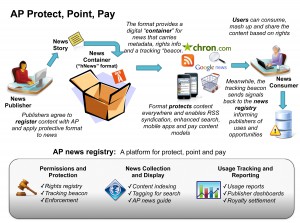OCLC and the Associated Press -- Two Sides of the Same Information Provider Coin?
I've run across a striking similarity between the bibliographic utility business and the newswire business, particularly in the area of cooperatives. Two cooperatives -- OCLC on the bibliographic utility side and the Associated Press on the newswire side -- have the same pattern of activity:
- both are membership organizations,
- both seek to amplify the efforts of members (bibliographic records in one case, news stories and photographs in the other),
- both are reacting to threats to content under its purview, and
- both have prominent members experimenting with new forms of content delivery and use.
I'll admit that this comparison between OCLC and the AP is not fully formed, but it has been running around in my mind long enough that it seemed appropriate to put it here. Feel free to run with this further if you think it has merit, or tell me that I'm nuts.
Membership Organizations
OCLC's "About" page describes itself this way:
Founded in 1967, OCLC Online Computer Library Center is a nonprofit, membership, computer library service and research organization dedicated to the public purposes of furthering access to the world's information and reducing the rate of rise of library costs. ((As an aside, this notion of "reducing the rate of rise of library costs" has really bothered me, especially lately. What we don't need is a reduction in the rate of rise; arguably, what we do need is a real reduction in costs from year to year. However, commentary on this aside is probably best explored in a separate post.))
Now, admittedly, OCLC is more than a bibliographic utility for sharing cataloging records, but, for the sake of this comparison, I'm focusing only on the cooperative cataloging part.
AP's "About" page describes itself this way:
AP's mission is to be the essential global news network, providing distinctive news services of the highest quality, reliability and objectivity with reports that are accurate, balanced and informed. AP operates as a not-for-profit cooperative with more than 4,000 employees working in more than 240 worldwide bureaus. AP is owned by its 1,500 U.S. daily newspaper members. They elect a board of directors that directs the cooperative.
For those of us in the library field, that probably sounds a great deal like OCLC's mission.
Reaction to Threats
The migration to a very digital world has posed a threat to the economic models that underly the activities of the cooperatives. As digital information has become easier to copy, it has become harder for the cooperatives to exert control over that information and receive payment-for-use of that information. In OCLC's case, the response was the Policy for Use and Transfer of WorldCat® Records and the corresponding reaction by the community. The original draft OCLC policy called for restrictions on sharing records and marking records with a 996 field that attributed the source of the record to OCLC.

Members Experimenting
The recent announcements of ‡biblios and SkyRiver and the libraries that are signing up with them makes this contrast even more stark.
On the AP side, the Tribune Company group of newspapers is running an experiment this week to use as little content from the Associated Press wire service as possible. Phil Rosenthal wrote about this on the Chicago Tribune "Tower Ticker" blog, and he continues:
The trial is scheduled to be conducted almost 13 months after Tribune Co. gave the AP a required two-year warning that it might drop the news service, effective Oct. 15, 2010. Tribune Co. said at the time that it was keeping its options open while weighing what role, if any, the AP would play in its future.
During the trial, Tribune Company papers will use as little AP content as possible. The papers will supplement from other sources, including Reuters, the Washington Post, and other news providers. American Public Media's Marketplace show had a segment last week on this experiment as well.
Conclusions
None. Although I'm able to draw what seem to be striking comparisons between OCLC and the AP, I'm not yet sure what can be learned from them, or what possibly OCLC and the AP can learn from each other. Hence the posting of this admittedly half-baked thesis here. I don't have time to take the work any further than this, but would be interested to hear the conclusions of someone(s) who decide to pick up this ball and run with it a bit farther.
The text was modified to update a link from https://biblios.net/ to http://biblios.net/ on February 11th, 2011.
The text was modified to update a link from http://marketplace.publicradio.org/display/web/2009/11/03/pm-no-more-ap-content/ to http://www.marketplace.org/topics/business/tribune-experiments-dropping-ap on November 19th, 2012.
The text was modified to remove a link to http://www.oclc.org/us/en/bibformats/en/9xx/996.shtm on August 22nd, 2013.